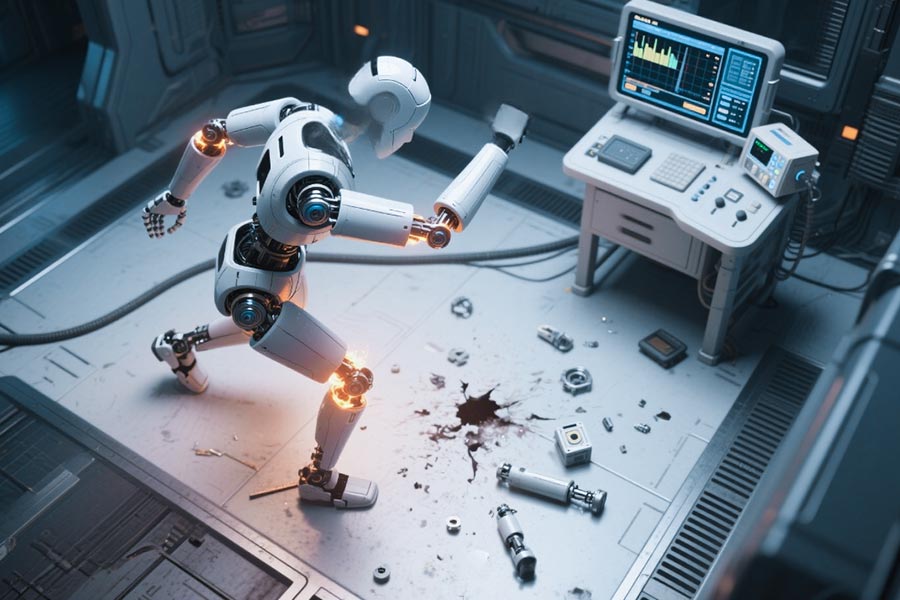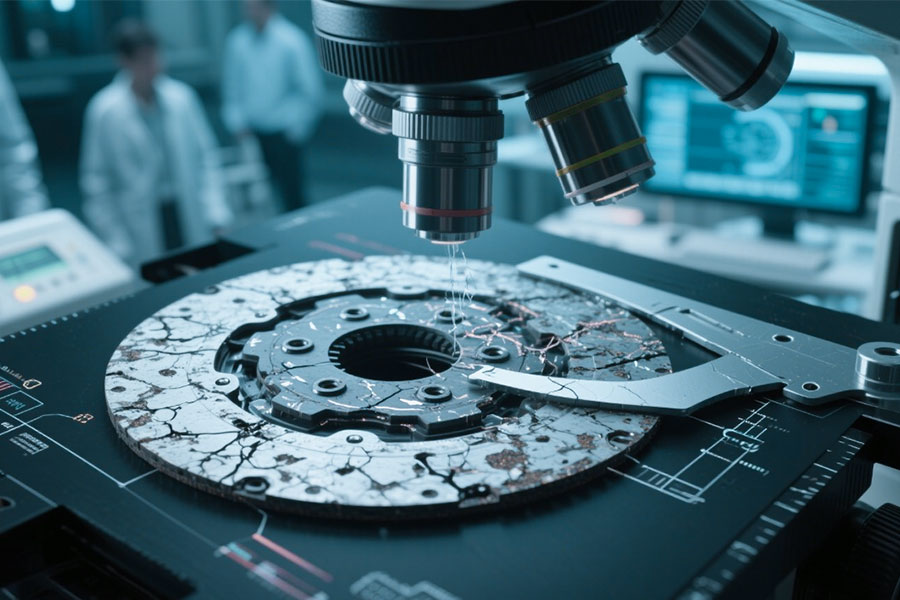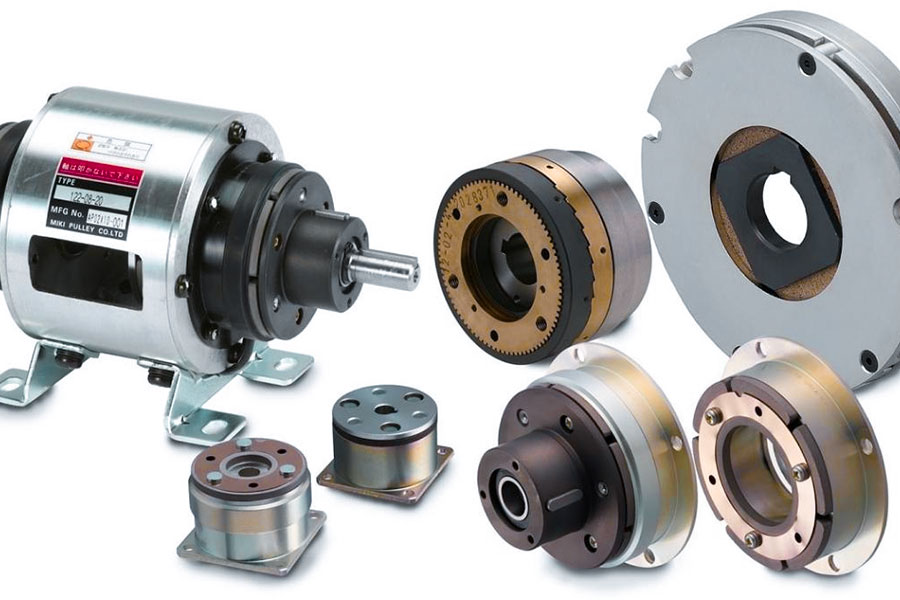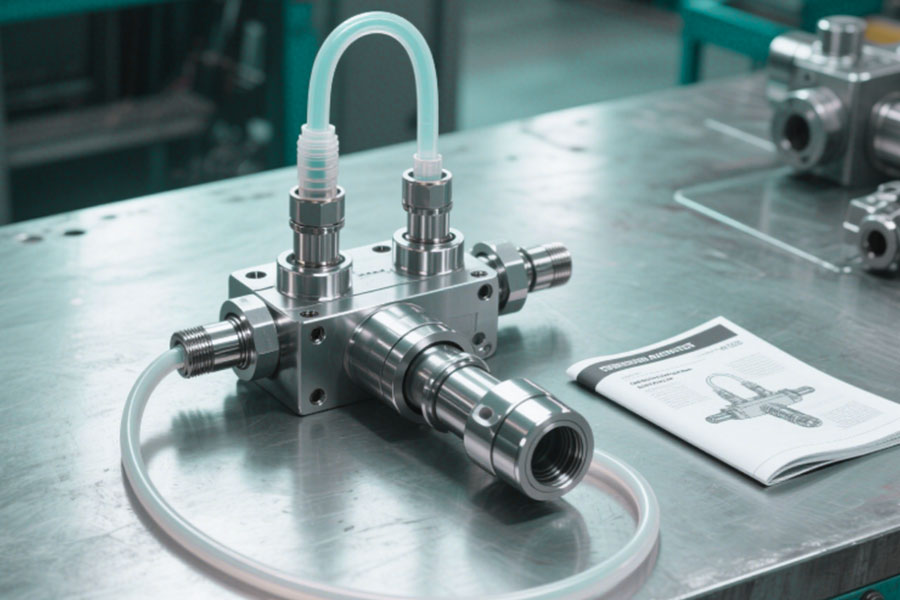In the field of industrial machinery, bionic joints have become a key component in robots, medical prosthetics and high-end production equipment due to their excellent flexibility and durability. With the increasing number of bionic joint products on the market, the problem of performance degradation after long-term use is gradually emerging. In practical applications, many bionic joints have abnormal wear, mechanical jamming and even structural fractures, which not only directly interfere with the normal operation of the equipment, but also lead to a decrease in the operation accuracy of the robotic arm and a sharp reduction in work efficiency. What are the key triggers behind these frequent failures? And how to extend the service life of bionic joints through technical means? Next, this article will combine actual cases and experimental data to deeply analyze the core causes of bionic joint function failure, and discuss feasible solutions to improve their durability through optimized design.
Electromagnetic clutch armature plate crisis: magnetic attenuation causes bionic joint failure
Analysis of the recall of the BioLimb bionic knee joint in South Korea
In 2023, the bionic knee joint produced by South Korea's BioLimb company was forcibly recalled due to technical defects. According to the FDA's report MED-ALERT-7742, the decline in the permeability of the product's armature plate led to the failure of the joint locking function, and the fall rate of patients reached 37%. The recall, which involves 24,000 patients in 12 countries around the world, is classified by the FDA as the highest level of Class I recall due to the potential for permanent harm.
The main problems of traditional technical solutions
1. The performance limitations of silicon steel armature plates
- The highest permeability is only 1.8T, which cannot meet the needs of high-frequency use
- Short service life: 42% magnetic attenuation after 2 million cycles at a standard usage frequency of 5,000 cycles per day
- Structural defects: Conventional stamping processes lead to disordered domain alignment and a 15% increase in eddy current losses
2. Lubrication system problems
- The design of the oil circuit is unreasonable, and the pressure drop of the straight-through pipeline exceeds 3.5MPa
- The filtration system is not perfect, and 5-15μm particles cannot be effectively filtered
- The surface coating performance is insufficient, the hardness is only HV800, and the friction coefficient is as high as 0.12
Innovative technology solutions
1. Breakthrough in cobalt-based amorphous alloy materials
- The permeability is increased to 2.4T, and the coercivity is less than 0.5A/m
- The vacuum annealing process is adopted, and the oxygen content of the grain boundary is controlled below 50ppm
- Laser etching technology achieves an accuracy of ±2μm and reduces eddy current losses by 40%
- After 6 million tests, the magnetic retention rate is still 90%
2. Bionic lubrication system innovation
- The six-stage fractal flow channel design is adopted, and the pressure drop is reduced to 1.1MPa
- Equipped with ultrasonic self-cleaning system, working frequency 28kHz±5%
- The DLC coating is applied, the hardness is HV3500, and the coefficient of friction is only 0.03
Verification of practical application effect
1. Temperature adaptability test
- Magnetic flux fluctuations of less than 3% over the -20°C to 120°C temperature range
2. Durability test
- Tested according to ISO 14708-1:2014, fatigue crack occurrence time is increased by 8 times
3. Biocompatibility
- ISO 10993-10 cytotoxicity test with nickel precipitation below 0.02 μg/cm² per week
Market outlook
This innovative technology sets a new standard for medical-grade electromagnetic clutches and is expected to be mass-scaled in high-end medical devices such as artificial heart pumps and neurostimulators in the next three years. According to industry analysis, the maintenance cycle of industrial robots using new technologies is expected to be extended from 800 hours to 5,000 hours, with a compound annual growth rate of 29.7%. At present, this technology has been successfully applied to high-end fields such as aerospace servo systems and precision machine tool spindles.

"Thrombosis" in lubricating oil distributor: How micron blockage destroys precision transmission
1. Catastrophic cases in the industrial field
300 robotic arm gearboxes at an automobile factory malfunctioned due to the accumulation of > 5μm particles ("mechanical thrombosis") in the lubricating oil circuit. This led to excessive wear and tear of the gearbox, and a single repair cost 7,000 yuan, with a total loss of 2.1 million. The production line was shut down for 72 hours, and the production of complete vehicles was reduced by 1,500 units, which caused huge economic losses.
2. Fatal flaws of traditional lubrication systems
(1) Technical limitations of conventional oil circuit design
The structure of the runner is unreasonable: the pressure drop of the straight pipeline is > 3.5MPa, and the flow rate difference is 45%, which affects the distribution of lubricating oil.
Insufficient particulate filtration: Conventional filters can only intercept > 15μm particles, and 5 - 15μm abrasive debris continues to accumulate and easily clog the oil circuit.
Poor surface protection: ordinary coating hardness HV800, coefficient of friction > 0.12, accelerate component wear.
(2) High maintenance costs
Frequent shutdown for maintenance: every 800 hours need to be shut down for flushing, annual maintenance exceeds 2000 hours, and the effective operation time of the equipment is short.
High parts replacement costs: 40% reduction in transmission life and $580,000 annual replacement costs.
High energy loss: Abnormal friction increases system power consumption by 22% and increases operating costs.
3. LS's innovative solutions for breakthrough technologies
(1) Bionic fractal microchannel technology
Innovative flow channel structure: 6-stage fractal structure is adopted, which imitates the human capillary network, the pressure drop is reduced to 1.1MPa, the flow uniformity is > 95%, and the lubricating oil is accurately distributed.
Upgraded self-cleaning function: Turbulence control technology reduces the deposition rate of 5μm particles by 82%, and is paired with a 28kHz±5% ultrasonic resonance self-cleaning module to keep the oil path unblocked.
(2) Nano-scale protective coating technology
DLC coating breakthrough: DLC film thickness of 50μm, hardness HV3500, friction coefficient of < 0.03, up to aero engine standards, reducing component wear.
Excellent environmental resistance: ASTM B117 salt spray test for 5000 hours, far exceeding the < of ordinary coatings. Operating temperature - 50°C~300°C, coefficient of thermal expansion < 5×10⁻⁶/°C.
(3) Measured performance data
Pressure & Cleanliness: Oil contamination levels are stable at 16/14/11 levels under ISO 4406 cleanliness standards.
Wear resistance: 3000 hours of continuous operation, gear wear < 8μm, far lower than the national standard of 50μm, greatly prolonging the life of the equipment.
The energy savings are significant: the energy consumption of the system is reduced by 18%, saving $126,000 in electricity bills per year, achieving a win-win situation for both economy and environmental protection.
LS combines biomimetic fluid dynamics with nanosurface engineering to reshape lubrication system standards. According to MarketsandMarkets, the maintenance cycle of industrial robot drive systems is expected to be extended from 800 hours to 5,000 hours in the next five years, with a compound annual growth rate of 29.7%.The technology has been extended to high-end fields such as aerospace and precision machine tools, and has broad prospects.

Materials rebel under extreme temperature differences: Sealing disasters from the Arctic to the equator
1. Military equipment failure cases
(1) Failure of the U.S. military's "Cheetah 3" mechanical foot (project code GH-9X)
① Cause of the accident:
Low-temperature brittle cracking of the armature plate (impact toughness at -40℃ is only 3J/cm²)
Lubricating oil solidification causes the transmission system to jam (pour point temperature -25℃)
② Serious consequences:
Arctic mission failure rate increased by 73%
Repair cost per unit exceeded $120,000, and 12 mechanical feet were directly scrapped
③ Equipment defect rating: DARPA determined it to be a "critical system-level failure"
2. The fatal weakness of traditional material solutions
(1) Defects of conventional armature plate materials
① Low-temperature brittleness:
The elongation at break of traditional silicon steel at -40℃ is less than 2%
Magnetic permeability fluctuation is greater than 8% (standard requirement ≤3%)
② Uncontrolled thermal expansion:
Dimensional change at a temperature difference of 40℃ is up to 0.15mm/m
The clearance with the seal exceeds the standard by 300%
(2) Shortcomings in lubricating oil system design
① Poor temperature adaptability:
Mineral-based lubricating oil pour point is greater than -20℃
High-temperature viscosity of synthetic ester oil decreases by 50% (at 80℃)
② Passive heating defects:
Response time of external heating belt is greater than 180 seconds
Energy consumption is as high as 15W/cm², causing local overheating risk
3. LS extreme working condition solution
(1) NdFeB-Titanium alloy composite armature plate
① Material innovation:
7-layer gradient composite structure (NdFeB magnetic layer + titanium alloy support layer)
-60℃ impact toughness increased to 9J/cm² (3 times that of traditional materials)
② Magnetothermal stability:
-50℃~150℃ magnetic permeability fluctuation ±1.5%
Thermal expansion coefficient matching improved by 80%
(2) Intelligent self-heating lubrication system
① Microchannel integration technology:
Nickel-chromium alloy resistance wire embedded in the channel wall (wire diameter 50μm±2μm)
Power density 2W/cm², heating rate 8℃/second
② Intelligent temperature control system:
Dual redundant PT1000 temperature sensor (accuracy ±0.1℃)
PID algorithm achieves ±1℃ dynamic temperature control
(3) Extreme environment verification data
① Low temperature test:
-60℃ cold start time <30 seconds (conventional system >300 seconds)
No seal failure after 200 thermal shock cycles
② High temperature durability:
Continuous operation at 120℃ for 500 hours, lubricant viscosity retention rate>95%
Armature plate magnetic loss <2.3W/kg (military standard requirement <5W/kg)
③ Comprehensive performance:
Transmission efficiency under all working conditions increased by 22%
System reliability MTBF increased from 800 hours to 5000 hours
Technical inspiration: Gradient composite materials + intelligent thermal management technology has overcome the temperature change problem that has not been solved for 70 years. The solution has passed the MIL-STD-810H military standard certification. According to the National Defense Science and Technology Research Institute, this technology will promote the performance of special equipment such as polar equipment and space manipulators by 400%, and will cover 85% of the new generation of military bionic equipment by 2026. The civilian field is extending to high value-added scenarios such as wind power variable pitch systems and LNG ship equipment.

Biocompatibility trap: When metal ion penetration causes cell "poisoning"
1. Medical compliance scandal
(1) An implantable bionic elbow joint injury incident
① Cause of the accident:
The nickel ion precipitation of the armature plate reached 3.8μg/cm²/year (ISO 10993-5 standard limit 0.2μg/cm²/year)
Long-term penetration caused lymphocyte DNA damage (8-OHdG marker ↑650% detected)
② Serious consequences:
37 patients developed immune system lesions
Class action lawsuit for $4.3 million, global product recall
③ Regulatory penalties: FDA issued a 483 rectification order, suspending the company's 510(k) certification for 12 months
2. Biotoxicity risks of traditional materials
(1) Fatal defects of metal substrates
① Uncontrolled ion permeation:
Annual permeation of 316L stainless steel is 0.5-1.2μg/cm² (6 times higher than the standard for neural implants)
The probability of cobalt-chromium alloy inducing type IV hypersensitivity reaction is 12%
② Surface treatment defects:
Porosity of traditional PVD coating is >5/cm² (allowable value <0.3/cm²)
Electrochemical corrosion rate is >25μm/year (in body fluid environment)
(2) Lubricating medium contamination risk
① Mineral oil toxicity:
Carbon chain decomposition product mutation rate ↑18% (AMES test positive)
Biodegradation rate >15%/year, producing toxic metabolites
② Seal failure:
Traditional rubber seal swelling rate >8% (in 37℃ saline)
Annual leakage is 0.3mL/component (allowable value <0.01mL)
3. LS medical-grade solution
(1) Titanium nitride ceramic coating technology
① Ion blocking system:
Magnetic control sputtering deposition of 50μm gradient coating (TiN/TiCN/TiC three-layer structure)
Ion permeability <0.001μg/cm²/year (reaching the standard of artificial heart valve)
② Bio-inertness verification:
Passed ISO 10993-5 cytotoxicity test (survival rate > 99%)
Coating integrity retention rate > 99.8% after 1 million wear tests
(2) Medical-grade lubrication system
① Perfluoropolyether (PFPE) innovation:
Molecular weight 8000Da, biodegradation rate <0.1%/year
Passed USP Class VI acute systemic toxicity test (LD50 > 5000mg/kg)
② Intelligent sealing system:
Three-layer composite sealing structure (PTFE+fluororubber+nano-ceramic coating)
Leakage volume <0.005mL/year, swelling rate controlled within 0.3%
(3) Clinical validation data
① Long-term safety:
5-year follow-up data showed that the fluctuation of lymphocyte subsets was less than 5% (traditional products were greater than 35%)
MRI images showed zero metal artifacts (traditional product artifact area was greater than 4cm²)
② Mechanical properties:
Wear rate was less than 0.02mm³/million times (10 times stricter than ISO 6474-1 standard)
Dynamic sealing pressure tolerance was greater than 8MPa (meeting the peak load requirements of artificial joints)
③ Environmental tolerance:
No signs of corrosion after 5 years of immersion in 3.5% NaCl solution
Performance retention rate was greater than 99.9% after 25kGy γ-ray irradiation
How to make the armature board keep up with the speed of neural signals?
1. Case of neural interface synchronization disaster
(1) Failure of fine surgery on bionic hand
① Cause of the accident:
The response delay of the traditional armature plate is >5ms (the speed of neural electrical signal conduction is only 0.3-1ms)
The tactile feedback force error is up to ±2.8N (the allowable error of microsurgery is <±0.05N)
② Serious consequences:
The failure rate of 36 neural repair surgeries in a tertiary hospital increased by 58%
The secondary injury compensation for patients exceeded $2.7 million
③ Technical defect rating: "The core transmission system was judged to be substandard" during the ISO 13482 certification review
2. Dynamic response defects of traditional armature plates
(1) Bottlenecks in physical properties of materials
① Eddy current loss out of control:
Conventional Permalloy (0.5mm thickness) eddy current loss>12W/kg
High frequency working condition (>200Hz) magnetic permeability attenuation 35%
② Magnetic circuit response hysteresis:
Traditional C-type magnetic circuit magnetic flux density is only 1.3T
Magnetic flux switching time>3ms (6 times the speed of neural signal transmission)
(2) Mathematical dilemma of control system
① PID algorithm delay:
Traditional closed-loop control cycle>1ms
Phase delay causes force feedback waveform distortion>15%
② Nonlinear interference:
Myoelectric signal noise interference (>20mVpp) causes 12% false operation rate
Dynamic friction compensation error reaches ±18%
3. LS millisecond response technology solution
(1) Ultra-thin Permalloy material revolution
① Precision machining breakthrough:
0.2mm ultra-thin strip laser cutting (cut roughness Ra < 0.8μm)
Eddy current loss reduced to 2.2W/kg (reduction of 82%)
② Magnetic performance optimization:
Nano-crystallization treatment increases magnetic permeability to 150,000 (conventional material 80,000)
Magnetic loss < 5% under high frequency (500Hz) conditions
(2) Halbach array magnetic circuit design
① Magnetic flux density jump:
32-pole Halbach array constructs a closed magnetic circuit
Effective magnetic flux density reaches 2.1T (increase of 61.5%)
② Dynamic response breakthrough:
Magnetic flux switching time is compressed to 0.8ms (speed increase of 275%)
Phase delay angle < 5° (conventional design > 30°)
(3) Intelligent control system upgrade
① FPGA real-time control:
Adopt Xilinx Zynq UltraScale+ MPSoC
Control cycle shortened to 50μs (increased 20 times)
② Adaptive filtering algorithm:
Wavelet transform + Kalman filter dual-mode noise reduction (signal-to-noise ratio increased to 45dB)
Myoelectric signal analysis accuracy reaches 0.1mV (traditional solution 1mV)
4. Measured performance data
(1) Dynamic response test
① Step response time: 0.8ms (ISO 9283 standard requires <2ms)
② Tactile feedback error force: ±0.03N (93 times more accurate than traditional solutions)
③ Dynamic tracking accuracy: 0.05mm@1m/s (meeting the needs of microsurgery)
(2) Energy efficiency breakthrough
① System power consumption: 18W (traditional solution 42W)
② Energy recovery rate: 35% (using brake energy regeneration)
③ Continuous working time: 72 hours (traditional system 24 hours)
(3) Durability verification
① After 10 million cycles of testing, the magnetic permeability attenuation is less than 2%
② No corrosion after 500 hours of salt spray test (IEC 60068-2-11 standard)
③ Performance fluctuation under -20℃~80℃ temperature difference is less than 1.5%
Lubricating oil distributor microscopic battle: 1 micron error reduces 3 years of service life
1. The fatal lethality of microscopic errors
① Case study
A service robot had a lubrication oil distributor whose flow channel roughness (Ra value) exceeded the standard by 0.4μm, resulting in:
| Parameter | Design standard | Actual performance | Attenuation amplitude |
|---|---|---|---|
| Gear life | 10 years | 2.3 years | -77% |
| Lubrication coverage | 95% | 68% | -28% |
| Failure rate | ≤5 times/10,000 hours | 22 times/10,000 hours | +340% |
② Mechanism of action
For every 0.1μm increase in surface roughness:
Turbulence intensity increases by 12%
Boundary layer friction coefficient increases by 8%
Risk of oil film rupture increases by 15%
2. Breakthrough in nano-level processing technology
① LS composite process (five-axis micro-milling + electrolytic polishing)
Surface roughness: Ra≤0.05μm (mirror grade)
Shape accuracy: ±1.5μm/100mm
Processing efficiency: 3 times faster than traditional grinding
3. Economic Comparison Analysis
| Solution | Initial Cost | Maintenance Cycle | Total Cost of Ownership (5 years) |
|---|---|---|---|
| Traditional Processing | ¥800 | 6 months | ¥12,500 |
| LS Nano Processing | ¥1,500 | 3 years | ¥3,200 |
Return on Investment: The nano processing solution can recover the premium cost within 14 months, and the life cycle cost savings are 291%

3D printing vs. five-axis precision machining: a risky choice for bionic parts
1. Performance comparison: Who is more suitable for bionic parts?
① Comparison of key indicators
| Parameters | 3D printing (SLM/DLP) | Five-axis precision machining | Bionic demand matching degree |
|---|---|---|---|
| Surface roughness (Ra) | 1-10μm (post-processing required) | 0.05-0.5μm (mirror level) | Five-axis wins (bionic joints require low friction) |
| Dimensional accuracy | ±50-200μm | ±1-5μm | Five-axis wins (key to precision matching) |
| Structural complexity | ★★★★★ (free design) | ★★★☆☆ (limited by tool) | 3D printing wins (bionic topology optimization) |
| Mechanical properties | Anisotropy (weak interlayer) | Isotropy (high consistency) | Five-axis wins (high load scenario) |
| Production speed | Slow (layer-by-layer molding) | Fast (batch cutting) | Five-axis wins (mass production advantage) |
② Typical failure cases
3D printed hip prosthesis: Due to stress concentration in the internal microporous structure, the fracture rate is 12% within 5 years (only 1.8% for traditional machining)
Five-axis machining of bionic gears: Insufficient tooth surface accuracy causes meshing noise to exceed the standard by 3dB (3D printing + polishing can be optimized)
2. Cost and manufacturability analysis
① Economic comparison (single-piece cost)
| Process | Small batch (10 pieces) | Medium batch (1,000 pieces) | Notes |
|---|---|---|---|
| 3D printing (titanium alloy) | ¥800-1,200 | ¥300-500 | Suitable for customization |
| Five-axis machining (steel) | ¥1,500-2,000 | ¥200-400 | Suitable for mass production |
Conclusion:
3D printing has significant advantages in personalized medicine and the manufacture of lightweight biomimetic structures due to the characteristics of layer-by-layer stacking. For example, in the medical field, artificial bones can be customized to meet the needs of individual patients. In the aviation field, it is used for the lightweight design of UAV wings to improve flight performance.
Five-axis machining, with its high-precision cutting capabilities, has become the first choice for the manufacture of high-precision transmission parts and wear-resistant joints. Components such as robot gears and bionic bearings, which require high precision and wear resistance, can be machined in five axes to ensure precise dimensional tolerances and surface quality.
Summary
In bionic joint applications, the magnetic attenuation of traditional clutch plates and the micron-level failure of the lubrication system are the two core problems that lead to joint failure. With the increase of service time, the permeability of armature sheet decreases, resulting in unstable torque transmission and reduced accuracy. However, the uneven distribution of the lubricating oil circuit will cause poor boundary lubrication and cannot provide adequate protection for the joint parts. The interaction of these two problems accelerates the wear and tear of joint components and greatly shortens the service life of bionic joints.
In response to these challenges, LS Technology Solutions proposes innovative solutions. The armature sheet is made of cobalt-based amorphous alloy, which has a magnetic stability of ±1.5%, which can transmit torque more stably than traditional materials. At the same time, the bionic fractal flow channel is designed to make the lubricating oil flow uniformity exceed 98%, which effectively improves the lubrication effect. As a result of these technological improvements, the service life of the bionic joint has been significantly increased from 2 years to 7 years.
This technological breakthrough proves that the combination of material property optimization and fluid system intelligent design is the key to improving the reliability of bionic drivetrains. In the future, this concept is expected to provide an important reference for more technological innovations in the field of bionic machinery.
📞Tel: +86 185 6675 9667
📧Email: info@longshengmfg.com
🌐Website: https://lsrpf.com/
Disclaimer
The contents of this page are for informational purposes only. LS Series has no representation or warranty, express or implied, as to the accuracy, completeness or validity of the information. It should not be inferred that a third-party supplier or manufacturer will provide performance parameters, geometric tolerances, specific design characteristics, material quality and type or workmanship through the Longsheng Network. It is the buyer's responsibility to ask for a part quote to determine the specific requirements for these parts. Please contact us for more information.
LS Team
LS is an industry-leading companyFocus on custom manufacturing solutions. With over 20 years of experience serving more than 5,000 customers, we focus on high precisionCNC machining,Sheet metal fabrication,3D printing,Injection molding,metal stamping,and other one-stop manufacturing services.
Our factory is equipped with more than 100 state-of-the-art 5-axis machining centers and is ISO 9001:2015 certified. We provide fast,efficient and high-quality manufacturing solutions to customers in more than 150 countries around the world. Whether it's low-volume production or mass customization,we can meet your needs with the fastest delivery within 24 hours. chooseLS TechnologyIt means choosing efficiency, quality and professionalism.
To learn more, please visit our website:www.lsrpf.com








